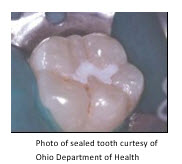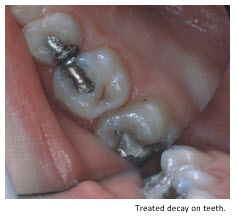Dental Sealants
Dental Sealants - A Cavity Fighting Tool!
What are dental sealants?
Dental sealants are a thin coating painted on the chewing surfaces of the back teeth (molars) to help prevent cavities. Sealants last for many years. A cavity is permanent damage to a tooth. A cavity can grow, cause tooth pain and become infected.
Sealants are placed by a dental professional. Having sealants placed on teeth is simple and painless. No tooth structure is removed when placing a sealant which makes sealants less expensive and easier to apply than fillings.
Why get sealants?

The most important reason for getting sealants is to avoid tooth decay. Cavities (tooth decay) is one of the most common childhood diseases Sealants can reduce cavities by 80% for two years and continue to protect against 50% of cavities for up to four years.
Fluoride in toothpaste and in drinking water protects the smooth surfaces of teeth but molars need extra protection. Sealants cover the chewing surfaces of the molars and help keep out germs and food.
Sealants need to be placed on teeth before cavities start. Sealants save time and money by preventing larger dental procedures to fix cavities.
What causes cavities?

The germs in our mouth cause cavities. The sugar in drinks and food that we eat is used by the germs to make acids. The acids can make a cavity in the tooth.
A healthy tooth is the best tooth. It is important to stop decay. That is why sealants are so important.
Why do molars get cavities so easily
The chewing surfaces of molars are rough and uneven because they have small pits and grooves. Food and germs can get stuck in the pits and grooves and stay there a long time because toothbrush bristles cannot brush them away.
Who should get sealants?
Children should get sealants on their adult molars as soon as the teeth come in and before cavities attach the teeth. Prevention is always better than the treatment of cavities.
The first adult molars come in when a child is 5 to 7 years old. The second adult molars come in when a child is 11 to 14 years old. Other teeth with pits and grooves may also need to be sealed. Teenagers and young adults could benefit from sealants.
Once applied, sealants protect against 80% of cavities for two years and continue to protect against 50% of cavities for up to four years. Children ages 6 to 11 years without sealants are almost three times more likely to get cavities than children with sealants.
Should sealants be put on baby teeth?
Baby teeth are important. Baby teeth help a child chew food, speak normally and save space for adult teeth. Your dentist might suggest sealants, especially if your child’s baby teeth have deep pits and grooves.
Does insurance pay for sealants?
Missouri Medicaid pays for sealants. Most dental insurance programs will pay for sealants. Check with MO HealthNet or your dental insurance company for details.
How long do sealants last?
Sealants can last up to 10 years or longer. Sealants need to be checked at regular dental check-ups. Sealants can chip or wear away. More sealant material can be added to repair sealants.
Are sealants new?
No, sealants have been around since the 1960s. Studies show that sealants are safe and effective at preventing cavities.
Where and how to get dental sealants for children
- Ask your dentist to apply sealants when adult molars have come in.
- Some schools partner with dental professionals to provide sealants in schools. Ask your child’s school if it has a dental professional or sealant program. If they do, sign your child up to participate.
- Some local health departments have dental professionals. Check with your local public health department.
If you need to find a dentist, use the search option at MO HealthNet, Clinic Locator for Medicaid and Sliding Fee Dental Services or Insure Kids Now Dentist Locator.

